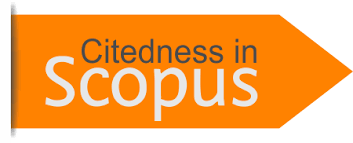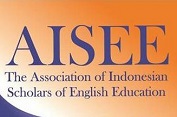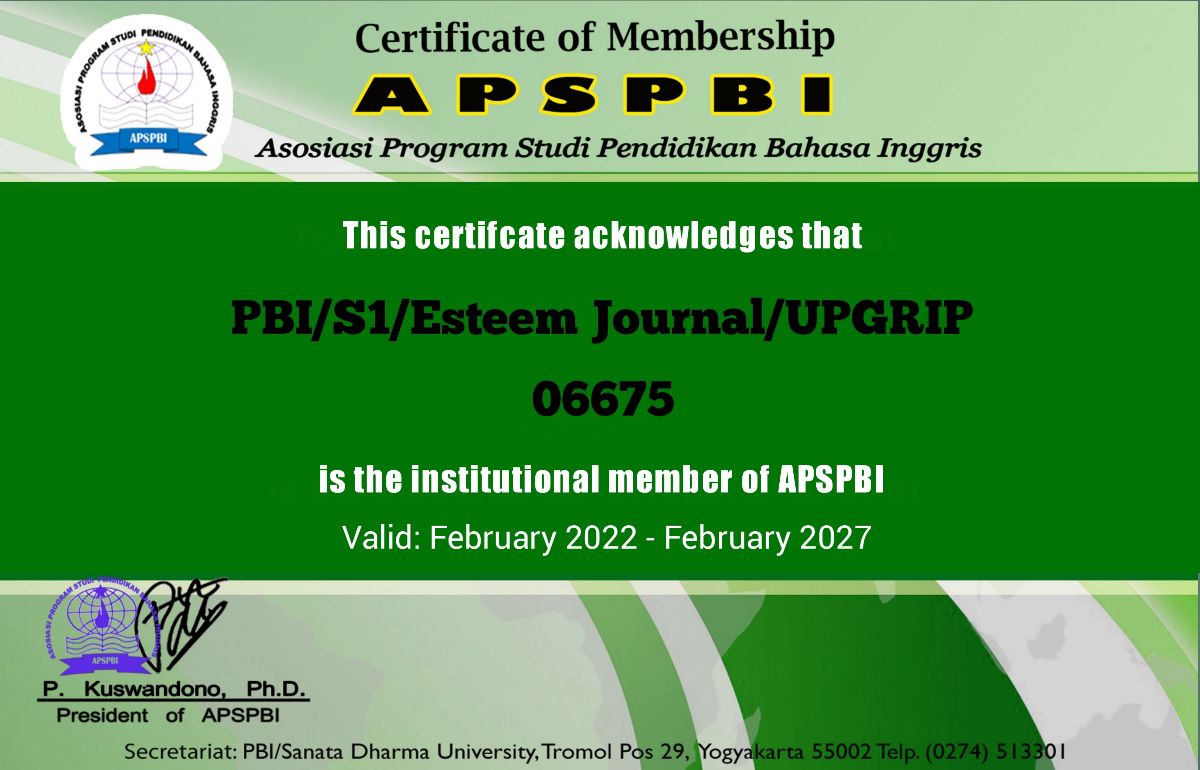IMPROVING STUDENTS’ WRITING ABILITY THROUGH QUICK WRITING STRATEGY TO THE ELEVENTH GRADERS OF SMA MUHAMMADIYAH PAGARALAM
DOI:
https://doi.org/10.31851/esteem.v5i1.7407Keywords:
Improving, Quick Writing strategy & Writing abilityAbstract
Writing is one of the most difficult skills to be mastered by students and most of students did not have enough ability to write, in order to solve this problem the writer used one of strategy which is quick writing. The main objective of this study was to identify whether or not the use of Quick Writing strategy was effective to enhance the student writing ability. The population was Eleventh grade students of SMA Muhammadiyah Pagaralam. In taking the sample, the researcher used purposive sampling. Sixty students, involved as a participants in this study. The research design used quasi experimental. The data were collected by using writing test. The data were analyzed by using paired sample t-test and independent sample t-test. The value t-obtain was (4.765) at the significant level 0.000. Since the value of t-obtained was higher than critical value of t-table (2.001). The result showed that there was significant difference between the students who were taught by using Quick writing strategy and those were not. In short, the students who were taught by using Quick writing strategy had better improvement in their writing ability. It was effective to use quick writing strategyReferences
Brown, H. D. (2000). Teaching by principles: An interactive approach to language pedagogy (2nd ed). San Francisco: Longman
Brown, D. (2001). Teaching by Principle an interactive approach to language pedagogy, (2nd ed). California : Longman.
Brown, H. D. (2007). Language assessment: Principles and classroom practice. San Francisco: Longman
Chapman, Jr.(2009). Teaching reading and writing : (A guidebook for tutoring and remediating students). in the United States of Americ, USA: A Division of Rowman & Littlefield Publishers, Inc.
Cohen, L., Manion, L., & Morrison, K. (2015). Research methods in education, (5th ed). NY : Routledge/Falmer Editon. England: Logman
Collin (2016). Cohesion, Coherence and Text Elements in Narrative Texts of Primary School Students, Ankara: Gazi University, Educational Science Institute (Unpublished PhD Thesis).
Fraenkel, J, R, Wallen, N, E (2012) How to design and Evaluate research in education.
Harmer, Jeremy. 2007. The Pratice of English Language Teaching, New Edition. London: Longman.
Heaton, Jb. (2010). Longman dictionary of language teaching & applied linguistics, (4th ed). Harlow : Longman Group UK Limited.
Jaya, A. Veto, A.V., Ferri, H. (2022). Instagram: A Learning Medium to Promote the Stdents’ English Productive Skills. SMART journal of English Language Teaching and Applied Linguistics. Vol. 7(2).
Kucer and Cecilia. (2013). Testing for language teacher, Melbourne : Cambridge University Press.
Nunan, D. (2010). Practical English Language Teaching Young Learners. Americas, New york, NY 10020.
O’Donell, Carol Porter. (2004). “Beyond the Yellow Highlighter: Teaching Annotation Skills to improve Reading Comprehension.†English Journal, 93(5), 82-89.
Richardson. (2012). English language teaching ( method, tools, techniques). Jaipur: Sunrise Publisher and Distributor.
Downloads
Published
Issue
Section
License
Copyright Notice
Authors who publish with this journal agree to the following terms:
In order to assure the highest standards for published articles, a peer review policy is applied. In pursue of the compliance with academic standards, all parties involved in the publishing process (the authors, the editors and the editorial board and the reviewers) agree to meet the responsibilities stated below in accordance to the Journal publication ethics and malpractice statement.
Duties of Authors:
- The author(s) warrant that the submitted article is an original work, which has not been previously published, and that they have obtained an agreement from any co-author(s) prior to the manuscript’s submission;
- The author(s) should not submit articles describing essentially the same research to more than one journal;
- The authors(s) make certain that the manuscript meets the terms of the Manuscript Submission Guideline regarding appropriate academic citation and that no copyright infringement occurs;
- The authors(s) should inform the editors about any conflict of interests and report any errors they subsequently, discover in their manuscript.
Duties of Editors and the Editorial Board:
- The editors, together with the editorial board, are responsible for deciding upon the publication or rejection of the submitted manuscripts based only on their originality, significance, and relevance to the domains of the journal;
- The editors evaluate the manuscripts compliance with academic criteria, the domains of the journal and the guidelines;
- The editors must at all times respect the confidentiality of any information pertaining to the submitted manuscripts;
- The editors assign the review of each manuscript to two reviewers chosen according to their domains of expertise. The editors must take into account any conflict of interest reported by the authors and the reviewers.
- The editors must ensure that the comments and recommendations of the reviewers are sent to the author(s) in due time and that the manuscripts are returned to the editors, who take the final decision to publish them or not.
Authors are permitted and encouraged to post online a pre-publication manuscript (but not the Publisher final formatted PDF version of the Work) in institutional repositories or on their Websites prior to and during the submission process, as it can lead to productive exchanges, as well as earlier and greater citation of published work (see The Effect of Open Access). Any such posting made before acceptance and publication of the Work shall be updated upon publication to include a reference to the Publisher-assigned DOI (Digital Object Identifier) and a link to the online abstract for the final published Work in the Journal.





























